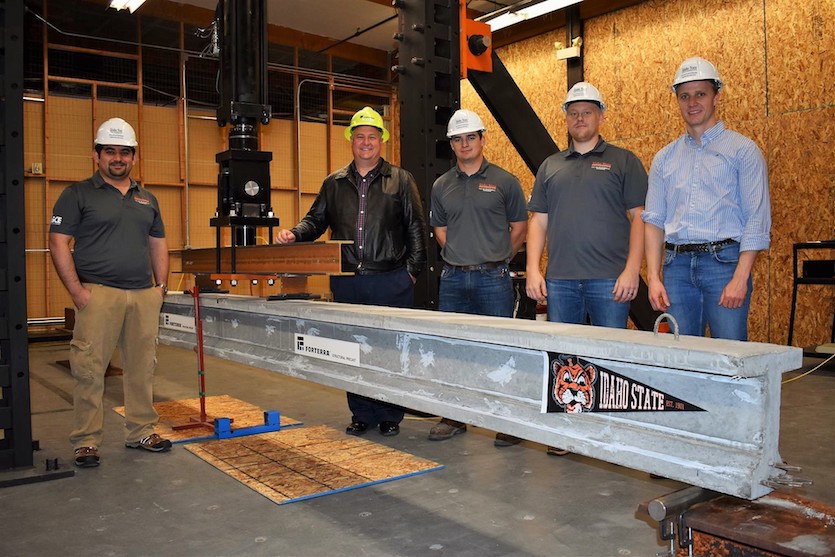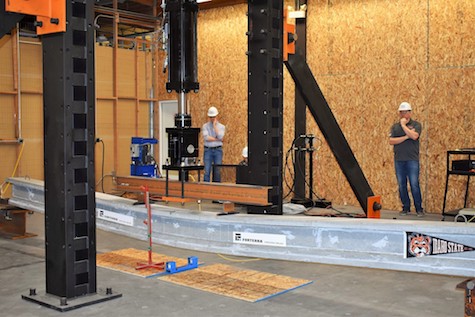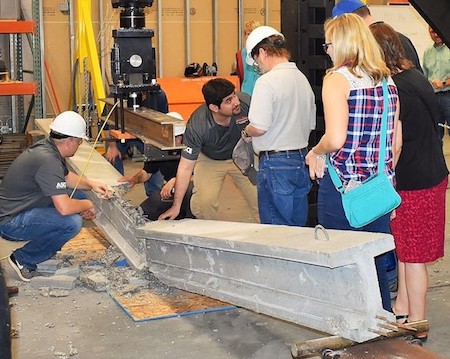ISU Big Beam tests well; team awaits results on how it placed
June 12, 2018

POCATELLO – It is only fitting that many of the Idaho State University Civil and Environmental Engineering students who helped build the new Structural Laboratory at the Engineering Research Complex would be the first to test their equipment.
The students, competing in the Precast/Prestressed Concrete Institute (PCI) Big Beam contest, tested the strength of their 21-foot long cement bridge beam at the Structural Laboratory using equipment that can produce forces in excess of 1 million pounds collectively.
“The students did a fantastic job for the first time entering the competition,” said faculty advisor is Mustafa Mashal, ISU assistant professor of civil and environmental engineering. “They did a fantastic job setting up the form work and helping with construction of the beam, the test setup and testing the lab equipment for the first time.”
 The PCI Big Beam team at ISU consists of graduate students Maximilian Casanova from Simi Valley, California, Christopher Clauson from Grand Forks, North Dakota, Karma Gurung from Nepal, undergraduate student Jared Cantrell from Mountain Home and graduate exchange scholar Henrik Karstens from Hamburg, Germany.
The PCI Big Beam team at ISU consists of graduate students Maximilian Casanova from Simi Valley, California, Christopher Clauson from Grand Forks, North Dakota, Karma Gurung from Nepal, undergraduate student Jared Cantrell from Mountain Home and graduate exchange scholar Henrik Karstens from Hamburg, Germany.
The students were judged on report quality, design accuracy, lowest cost, lowest weight, largest measured deflection at maximum total applied load, most accurate prediction of deflection, cracking load and failure load. They were also judged on the beam’s practicality, innovation and conformance with code. During testing, the beam was stronger than predicted and the students were close in predicting its deflection value.
The students, who tested the beam in late May, easily met the contest deadline to have their results reported by June 15. The team will receive word on how they fared in the competition this fall. They are competing against students at large universities such as Notre Dame, Iowa State and Oregon State Universities.
Mashal said he was also pleased by the performance of the lab’s equipment.
“This was the first time the lab was in action, the first time the machines could flex their muscles,” Mashal said. “We have larger scale testing available for more research. This was a test for it and the machine performed well, the computers performed well and the safety protocols performed well.”
The students’ beam was tested as a simply supported 20-foot span, with the overall length limited to 22 feet. The beam was designed so it would not crack below 20,000 pounds of loading and was designed to fail within the range of 32,000 to 39,000 pounds.

The ISU team is sponsored by Forterra Structural Precast in Salt Lake City, Utah for the 2018 PCI Big Beam Competition.
A video of the ISU team’s beam being tested is available online at https://www.youtube.com/watch?v=8t98QGkq2YE.
Middle photo: Beam during testing.
Bottom photo: Beam after testing.

